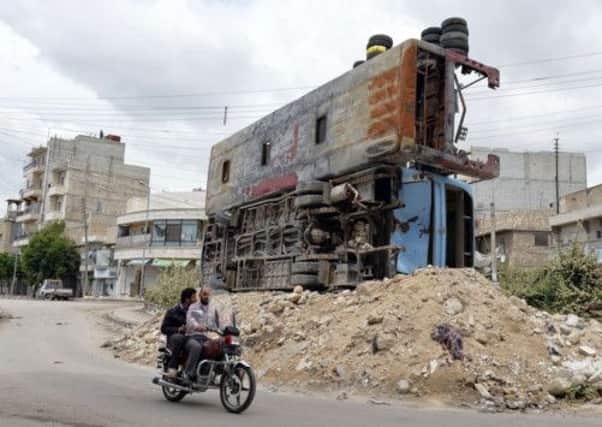Syria: Over 100 die in ‘horrifying civilian massacre’


If the accounts are confirmed, the killings in the mainly Sunni Muslim suburb of Jdeidet al-Fadel would amount to one of bloodiest episodes of the two-year-old uprising against the Assad regime. Many of the dead were civilians, the activists said.
A statement by the Syrian National Coalition umbrella opposition group, issued from Istanbul, said the death toll “has reached the hundreds” and described the killings as a “horrifying civilian massacre”.
Advertisement
Hide AdAdvertisement
Hide Ad“The deafening silence of the international community over these crimes against humanity is shameful, and has become routine for the victims and their families,” the statement said.
“Syrians no longer expect an answer to our pleas for help or a chivalrous intervention from our brothers and neighbours. We no longer expect to be supported with the necessary arms to empower the Free Syrian Army to defend our people.”
Syrian state media gave no death toll, but confirmed the army had been fighting in the town. It said it had saved Jdeidet al-Fadel from what it described as criminal terrorist groups.
On Sunday, activists said at least 85 people had been killed and the toll might reach 250. With the army beginning to pull back, they said more accounts were emerging.
The activists, speaking from the area, which lies six miles south-west of Damascus, said residents had buried some victims in the early stages of the five-day attack by elite forces and pro-Assad militias. More bodies were now being found burnt or apparently killed in summary executions, they said.
Rebel brigades withdrew two days ago, they said, leaving Mr Assad’s forces in total control.
The working-class district is one of several Sunni Muslim towns surrounding the capital that have been at the forefront of the uprising. It is situated near hilltop bases of elite forces which are mostly from Mr Assad’s minority Alawite sect.
Shamel al-Golani, of the opposition Sham News Network, said one of the hardest hit areas was a neighbourhood adjacent to the 100 Brigade, one of several elite units based around Jdeidet al-Fadel.
Advertisement
Hide AdAdvertisement
Hide Ad“In the first three days the army would go into neighbourhoods and commit killings and withdraw and come back the next day,” he said.
“Many of them who were killed early were refugees from Daraya and al-Mouadamiya and were buried quietly,” he added, referring to two adjacent suburbs that have been the scene of several army incursions.
Mr Assad’s forces have been accused of massacring hundreds of Sunni Muslims in areas they have stormed. International rights groups say rebel forces have also committed atrocities, although on a smaller scale.
Jdeidet al-Fadel lies on the road from Damascus to the Israeli-occupied Golan Heights. In the last year thousands of families from nearby areas took shelter in the town.
The Syrian Organisation for Human Rights, Sawasiah, which put the death toll at 500, said the army forces included elite Republican Guards and artillery brigades. Units of “sectarian militia” supported by members of air force intelligence, one of the most feared of myriad secret police branches, accompanied the army units, it said.
According to witnesses interviewed by the Syrian organisation, water and electricity were cut off and Mr Assad’s forces stopped residents from leaving by blocking roads in and out.
Sawasiah said many of the victims were civilians, targeted because the suburb was an “incubator for armed resistance” and they had showed solidarity with refugees in adjacent towns also subjected to mass killings.